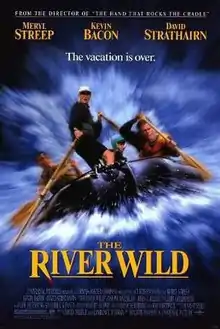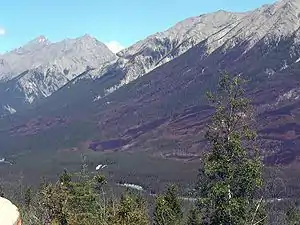The River Wild
The River Wild is a 1994 American adventure thriller film directed by Curtis Hanson and starring Meryl Streep, Kevin Bacon, David Strathairn, John C. Reilly, Benjamin Bratt, and Joseph Mazzello as Roarke.[2] It is about a family on a whitewater rafting trip who encounter two violent criminals in the wilderness.
| The River Wild | |
|---|---|
 Original theatrical poster | |
| Directed by | Curtis Hanson |
| Produced by | |
| Written by | Denis O'Neill |
| Starring | |
| Music by | Jerry Goldsmith |
| Cinematography | Robert Elswit |
| Edited by | |
| Distributed by | Universal Pictures |
Release date |
|
Running time | 108 minutes |
| Country | United States |
| Language | English American Sign Language |
| Budget | $45 million[1] |
| Box office | $94.2 million |
Plot
A Boston couple, Gail (Meryl Streep) and Tom Hartman (David Strathairn) are having marital problems, mostly due to Tom, an architect, spending so much time working. Gail, a history teacher and former river guide, is taking their son, Roarke (Joseph Mazzello), on a rafting trip down the Salmon River in Idaho, along with their dog, Maggie. Daughter, Willa (Stephanie Sawyer), is staying behind with Gail's parents in Idaho. Tom, who had remained in Boston, unexpectedly joins them at the last minute. As they are setting off, they meet three other rafters, Wade (Kevin Bacon), Terry (John C. Reilly), and Frank (William Lucking), who appear to be friendly.
The Hartmans catch up with the trio during a day break, and notice that Frank is no longer with Wade and Terry. They explain that Frank hiked out after an argument. Unfortunately, Frank was their guide, and Wade and Terry lack any rafting experience. Gail offers to guide them down the rest of the river. Before getting back on the water, Maggie wanders off and becomes curious about something in the brush farther up the canyon. Tom fetches her before she uncovers it, and they return to the boat.
After a day's rafting, they make camp for the night, but Tom continues working on his architectural project, disappointing Roarke, who feels neglected. They are joined by Wade and Terry, who help celebrate Roarke's birthday that night. After Wade begins acting suspiciously, Gail agrees with Tom that they should part ways with the men. Their plans are upended when the men shove off first with Roarke aboard their raft. Wade, showing off to Roarke, reveals they have a gun. During a rest stop, Gail and Tom attempt to take off with Roarke before Wade and Terry notice. The attempt fails, and Wade pulls the gun on Tom. As they struggle, Maggie runs off into the bushes. Gail then realizes that Wade and Terry committed a recently reported robbery and have killed Frank.
The Hartmans are forced down the river at gunpoint before setting up camp for the night. During the night, Tom tries and fails to wrestle the gun away from Terry. Tom runs into the river with Wade chasing, but he escapes; Wade lies, telling Gail and Roarke that Tom is dead. The next day they run into Johnny, a park ranger (Benjamin Bratt) who knows Gail. Wade holds the gun to Gail's back as they pretend everything is okay.
Wade and Terry's escape plan includes rafting down the Gauntlet, a dangerous and now restricted rapids section that Gail once successfully navigated. Johnny returns later, suspecting Gail intends to run the Gauntlet, and warns her not to try. Wade shoots Johnny and throws his body into the rapids.
Unbeknownst to anyone, Tom, who finds Maggie, is racing on foot along the canyon rim to get ahead of the raft. After a harrowing ride, the group makes it through the Gauntlet. Tom reappears, and flips the raft. As Tom struggles with Terry, Gail is able to get the gun. She shoots and kills Wade while Tom subdues Terry. The film ends with the Hartmans and Terry, who has been arrested, being helicoptered out.
Cast
- Meryl Streep as Gail Hartman
- Kevin Bacon as Wade
- David Strathairn as Tom Hartman
- Joseph Mazzello as Roarke Hartman
- John C. Reilly as Terry
- Benjamin Bratt as Ranger Johnny
- Elizabeth Hoffman as Gail's Mother
- Victor H. Galloway as Gail's Father
- Diane Delano as Ranger
- Thomas F. Duffy as Ranger
- William Lucking as Frank
- Paul Cantelon as Violinist
- Glenn Morshower as Policeman
- Stephanie Sawyer as Willa Hartman
Pre-production and filming

In June 1993, Universal Studios began considering locations along the Middle Fork of the Flathead River and the Kootenai River in Montana. They also began to seek permits from the forest service and permission from private landowners to film near the falls and nearby West Glacier. Other than Montana for locations, the studio then began to scout the areas in Washington, Oregon, Idaho and Wyoming. Before filming began, the crew spent two weeks doing research and development on whitewater rafting.
Principal photography began in late July 1993. Many of the film's whitewater scenes were filmed on the Kootenai River. Other scenes were filmed on the Ruby Horsethief section of the Colorado River, the Rogue River in Southern Oregon, and the Middle Fork of the Flathead River. Streep did several of her own stunts in the film, on the milder river sections. The major whitewater stunts were performed by expert professional river guide Kelley Kalafatich who was hired as Streep's stunt double for the movie.
There was a scare at the end of one day of filming when Hanson asked Streep to shoot one more scene, to which she objected because of her exhaustion. However, she decided to attempt it, and weak from fatigue, was swept off the raft into the river and was in danger of drowning; she did not drown because of her personal flotation device and the river rescue team. Afterwards she said to Hanson, "In the future, when I say I can't do something, I think you should believe me," to which he agreed.[3]
After completing filming all the whitewater sequences in Montana & Oregon, the main cast & crew then went to Boston, Massachusetts to film the remaining scenes from the beginning of the film. Production was completed in November.
Stunts & safety
Many of the scenes were filmed in dangerous locations which required that specialized whitewater river professionals perform the river stunts and provide the needed safety for Streep and the other cast members. Streep also did some of her own stunts.
Music
The film was initially scored by Maurice Jarre, but after the producers threw his work out, Jerry Goldsmith was signed to rescore the project (footage of the Goldsmith scoring sessions was used in the 1995 documentary Film Music Masters: Jerry Goldsmith, with extended footage of same as a DVD bonus). Although Goldsmith took a different approach to Jarre, both composers incorporated the folk song "The Water Is Wide" into their scores; the Cowboy Junkies also recorded a version of the song for the end credits. RCA Victor released a soundtrack album on September 13, 1994.
On January 19, 2014, Intrada Records released a limited-edition album, with Goldsmith's score and alternates on disc one and Jarre's unused music on disc two. Tracks in bold also appear on the RCA album, mostly under different names.
Release
The film premiered on September 30, 1994, in the United States. The film grossed a total of $94,216,343 worldwide, earning $46,816,343 in the United States and $47,400,000 internationally.[4]
Reception
As of December 2020, the film holds a 58% approval rating on Rotten Tomatoes, based on 33 reviews.[5] Film critic James Berardinelli praised the production values of the cinematography and score, and the pace of the rafting experience. He also praised Hanson's directing, likening it to that like The Hand That Rocks the Cradle (1992), stating that Hanson, "could manipulate characters and situations within the comfortable confines of a formula plot", and describing The River Wild as a "level of excitement designed to submerge implausibilities and minor gaffes, and a film which "braves the rapids while keeping the viewer afloat amidst its churning waters".[6] He also praised Streep's powerful performance as a female action hero, but described the film overall as "a cut below a white-knuckler".[6]
Roger Ebert of the Chicago Sun Times also said the best elements of the film were its cinematography, which he described as "great looking", and the performances of Bacon and Streep; he described the latter as "putting a lot of humor and intelligence into her character".[7] However, Ebert identified serious flaws in the strength of the plot, remarking that, "movies like this are so predictable in their overall stories that they win or lose with their details ...The River Wild was constructed from so many ideas, characters and situations recycled from other movies that all the way down the river I kept thinking: Been there".[7] He emphasized the lack of credibility in the storyline and sheer impossibility of some scenes, particularly involving Strathairn as he outruns the pace of the river, and his scenes with the cliff and his Swiss Army knife.[7]
Nominations, awards, and recognitions
Streep received a nomination for the Golden Globe Award for Best Actress in a Motion Picture – Drama and the Screen Actors Guild Award for Outstanding Performance by a Female Actor in a Leading Role. She lost the former to Jessica Lange in Blue Sky and the latter to Jodie Foster in Nell. Bacon received a nomination for the Golden Globe Award for Best Supporting Actor – Motion Picture. He lost to Martin Landau in Ed Wood.
In 2003, the American Film Institute nominated Gail as a hero from this film for AFI's 100 Years...100 Heroes & Villains.[8]
Year-end lists
- Honorable mention – William Arnold, Seattle Post-Intelligencer[9]
- Honorable mention – David Elliott, The San Diego Union-Tribune[10]
- 6th worst – John Hurley, Staten Island Advance[11]
References
- "The River Wild (1994)". The Numbers. Archived from the original on August 16, 2016. Retrieved July 4, 2016.
- "The River Wild". Turner Classic Movies. Atlanta: Turner Broadcasting System (Time Warner). Archived from the original on June 12, 2018. Retrieved July 11, 2016.
- "10 Iconic Movie Scenes That Nearly Killed Their Stars: 2. Meryl Streep: The River Wild". MoviesTalk. Archived from the original on 31 May 2014. Retrieved 30 May 2014.
- "The River Wild at Box Office Mojo". Archived from the original on January 7, 2010. Retrieved October 4, 2010.
- rottentomatoes.com, "The River Wild (1994) Archived 2017-11-29 at the Wayback Machine", Accessed November 30, 2017.
- Beradinelli, James (1994). "The River Wild". Reelviews.net. Retrieved March 18, 2009.
- Ebert, Roger (1994). "The River Wild". Chicago Sun Times. Archived from the original on September 30, 2007. Retrieved March 18, 2009.
- "AFI's 100 Years...100 Heroes & Villains Nominees" (PDF). Archived (PDF) from the original on 2018-10-17. Retrieved 2016-08-12.
- Arnold, William (December 30, 1994). "'94 Movies: Best and Worst". Seattle Post-Intelligencer (Final ed.). p. 20.
- Elliott, David (December 25, 1994). "On the big screen, color it a satisfying time". The San Diego Union-Tribune (1, 2 ed.). p. E=8.
- Hurley, John (December 30, 1994). "Movie Industry Hit Highs and Lows in '94". Staten Island Advance. p. D11.